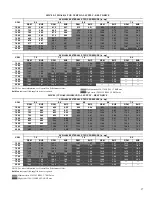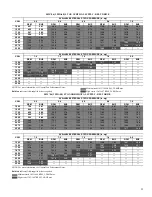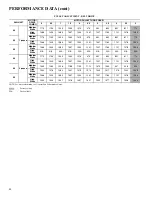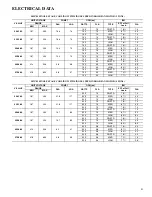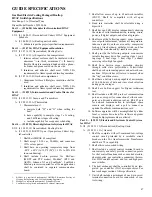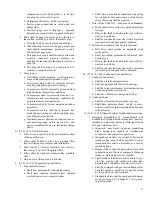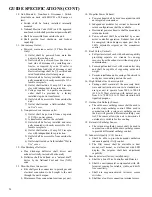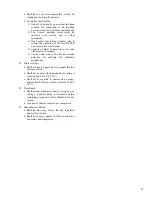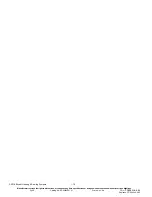
50
temperature limit switch. Fault indication shall
be made using an LED.
3. Standard Heat Exchanger construction
a. Heat exchanger shall be of the tubular-section
type constructed of a minimum of 20-gage steel
coated with a nominal 1.2 mil aluminum-sili-
cone alloy for corrosion resistance.
b. Burners shall be of the in-shot type constructed
of aluminum-coated steel.
c. Burners shall incorporate orifices for rated heat
output up to 2000 ft (610m) elevation. Addi-
tional accessory kits may be required for appli-
cations above 2000 ft (610m) elevation,
depending on local gas supply conditions.
d. Each heat exchanger tube shall contain multiple
dimples for increased heating effectiveness.
4. Optional Stainless Steel Heat Exchanger construction
a. Use energy saving, direct-spark ignition system.
b. Use a redundant main gas valve.
c. Burners shall be of the in-shot type constructed
of aluminum-coated steel.
d. All gas piping shall enter the unit cabinet at a
single location on side of unit (horizontal
plane).
e. The optional stainless steel heat exchanger shall
be of the tubular-section type, constructed of a
minimum of 20-gage type 409 stainless steel.
f. Type 409 stainless steel shall be used in heat
exchanger tubes and vestibule plate.
g. Complete stainless steel heat exchanger allows
for greater application flexibility.
5. Optional Low NOx Heat Exchanger construction
a. Low NOx reduction shall be provided to reduce
nitrous oxide emissions to meet California’s Air
Quality Management District (SCAQMD) low-
NOx emissions requirement of 40 nanograms
per joule or less.
b. Primary tubes and vestibule plates on low NOx
units shall be 409 stainless steel. Other compo-
nents shall be aluminized steel.
6. Induced draft combustion motor and blower
a. Shall be a direct-drive, single inlet, forward-
curved centrifugal type.
b. Shall be made from steel with a corrosion-resis-
tant finish.
c. Shall have permanently lubricated sealed
bearings.
d. Shall have inherent thermal overload protection.
e. Shall have an automatic reset feature.
I. (23 81 19.13.I) Coils
1. Standard Aluminum Fin - Copper Tube Coils:
a. Standard evaporator and condenser coils shall
have aluminum lanced plate fins mechanically
bonded to seamless internally grooved copper
tubes with all joints brazed.
b. Evaporator coils shall be leak tested to 150 psig,
pressure tested to 450 psig, and qualified to UL
1995 burst test at 1775 psig.
c. Condenser coils shall be leak tested to 150 psig,
pressure tested to 650 psig, and qualified to UL
1995 burst test at 1980 psig.
2. Optional Pre-coated aluminum-fin condenser coils
(3 Phase Models Only):
a. Shall have a durable epoxy-phenolic coating to
provide protection in mildly corrosive coastal
environments.
b. Coating shall be applied to the aluminum fin
stock prior to the fin stamping process to create
an inert barrier between the aluminum fin and
copper tube.
c. Epoxy-phenolic barrier shall minimize gal-
vanic action between dissimilar metals.
3. Optional Copper-fin evaporator and condenser
coils (3 Phase Models Only):
a. Shall be constructed of copper fins mechani-
cally bonded to copper tubes and copper tube
sheets.
b. Galvanized steel tube sheets shall not be
acceptable.
c. A polymer strip shall prevent coil assembly
from contacting the sheet metal coil pan to min-
imize potential for galvanic corrosion between
coil and pan.
4. Optional E-coated aluminum-fin evaporator and
condenser coils (3 Phase Models Only):
a. Shall have a flexible epoxy polymer coating
uniformly applied to all coil surface areas with-
out material bridging between fins.
b. Coating process shall ensure complete coil
encapsulation of tubes, fins and headers.
c. Color shall be high gloss black with gloss per
ASTM D523-89.
d. Uniform dry film thickness from 0.8 to 1.2 mil
on all surface areas including fin edges.
e. Superior hardness characteristics of 2H per
ASTM D3363-92A and cross-hatch adhesion of
4B-5B per ASTM D3359-93.
f. Impact resistance shall be up to 160 in.-lb
(ASTM D2794-93).
g. Humidity and water immersion resistance shall
be up to minimum 1000 and 250 hours respec-
tively (ASTM D2247-92 and ASTM D870-92).
h. Corrosion durability shall be confirmed through
testing to be no less than 1000 hours salt spray
per ASTM B117-90.
J. (23 81 19.13.J) Refrigerant Components
1. Refrigerant circuit shall include the following con-
trol, safety, and maintenance features:
a. Fixed orifice metering system shall prevent
mal-distribution of two-phase refrigerant by
including multiple fixed orifice devices in each
GUIDE SPECIFICATIONS (CONT)


